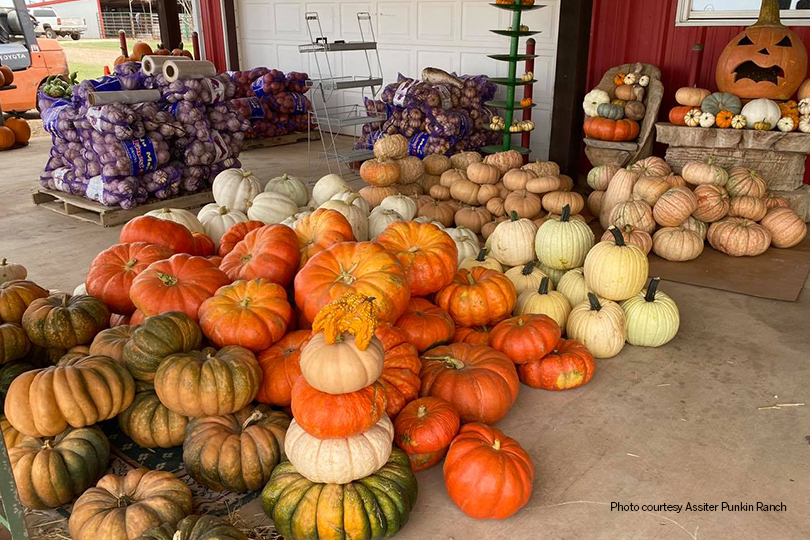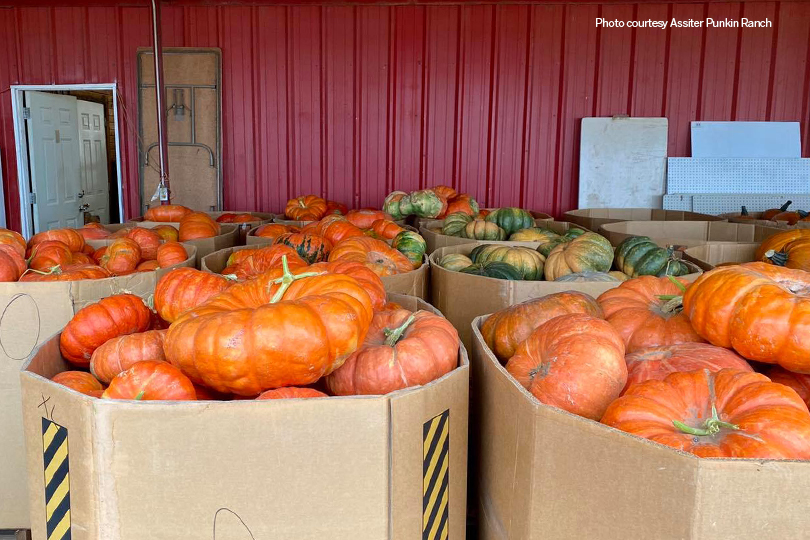By Jennifer Dorsett
Field Editor
While much of Texas doesn’t experience a dramatic shift in weather to celebrate the transition to fall, many honor the arrival of autumn by decorating with hay bales and pumpkins.
And the carefully-carved pumpkins that decorate homes may have started in a pumpkin patch in Texas.
A large portion of pumpkins for sale in Texas are grown in Floyd County, northeast of Lubbock.
And Floydada, the county seat, is known as Pumpkin Capital, USA.
The story begins in the mid-20th Century with B.A. “Slim” Robertson.
Robertson was a longtime farmer in the area who grew the first crop of pumpkins some time in the late 1950s, according to local lore.
“Uncle Slim, as I called him, started my dad to raising pumpkins in the 1960s,” Tim Assiter, who grows pumpkins and operates Assiter Punkin Ranch, said. “He was really the first one to grow pumpkins here, and through trial and error, just figured some things out and shared that knowledge with other farmers.”
And it grew from there.
Throughout the years, more farmers started growing pumpkins. Assiter estimates by the mid-1990s, there were 30-45 growers in Floyd County growing about 3,000 acres of pumpkins each year.
While Assiter’s family had grown pumpkins on the side during that time, their operation didn’t really take off until 1992.
“My dad had been growing pumpkins all those years, but after my mom retired, she started taking some of the pumpkins that maybe weren’t as perfectly round as those they were sending to market and using them to line her driveway as decoration in the fall,” Assiter said. “Then, people started stopping by and saying ‘Hey,
I’d like to buy a pumpkin.’ So, in 1993, I set up a little retail location at their house where we had different bins of pumpkins, and someone sat out there all the time to sell them.”
Over the next five years, word spread quickly and the Assiter Punkin Ranch was an official success.
Then, in 2000, the Assiter family built a big red barn and now have visitors from all over the state and world stop by to experience fall on the pumpkin ranch.
“We now offer a whole experience,” Assiter said. “We have sheep, goats, mini horses and mini donkeys, a wonderful pumpkin mini train ride for the kids, cotton candy and popcorn machines, and of course, pumpkins and gourds for sale. It’s just a good way to spend a day with your family.”
And there’s a wide variety of pumpkins for sale.
“Our website claims we raise 71 varieties of pumpkins, but I think that’s missing it by half,” he said. “We have orange pumpkins in small, medium and extra-large sizes. Then you have blues, pinks, reds, white, greens, tans and specialty squash in every color of the rainbow with variegations. We definitely have something for everybody.”
Although Assiter enjoys growing pumpkins, he said it’s not always easy.
“We have two issues that restrict pumpkins—labor and water. Pumpkins cannot be harvested mechanically, because machines scratch them up and damage them too much for retail,” he said. “The second thing is water. We have reduced acres for years in this area, because the water table is getting lower and lower.”
But farmers have improved their methods, too.
“There were probably 40 growers in the mid-1990s raising 3,000 acres of pumpkins. Today, three growers raise just under 1,000 acres of pumpkins,” Assiter said. “The amazing thing to me is the number of pumpkins we produce is very close to what we were producing in the 1990s on three times as many acres, because we’ve improved irrigation, farming practices and varieties. We’re not trying to water 3,000 acres anymore. We’re concentrating the water and fertilizer on fewer acres to grow more.”
For more information on the Assiter Punkin Ranch, visit https://pumpkinranch.com.


